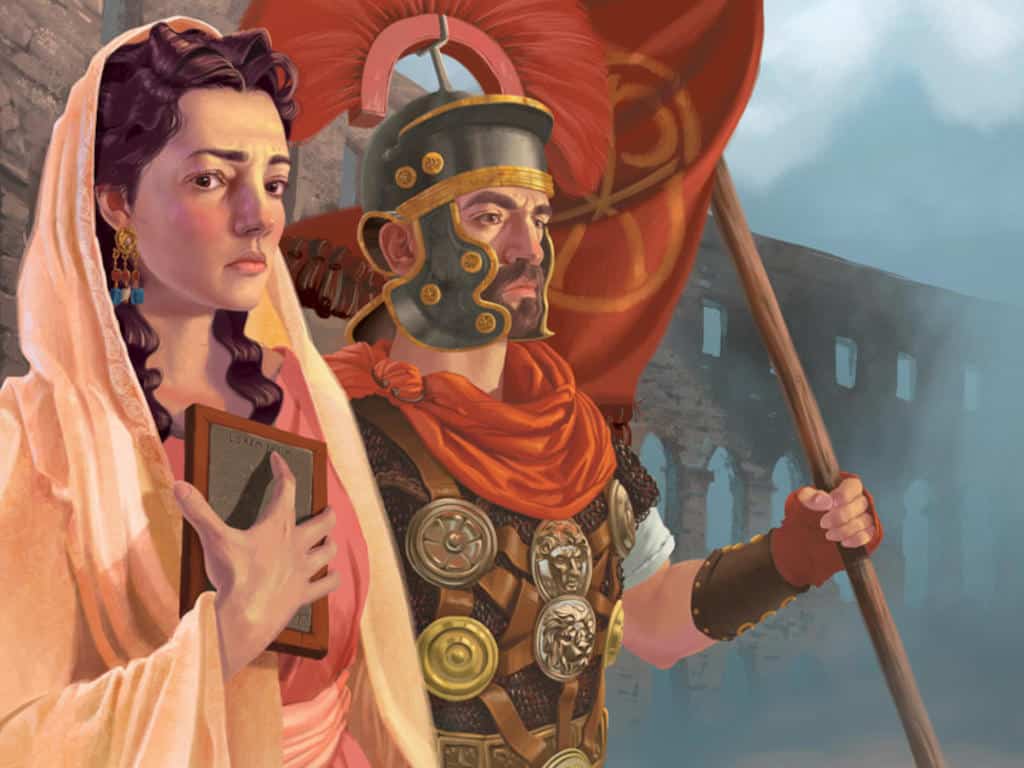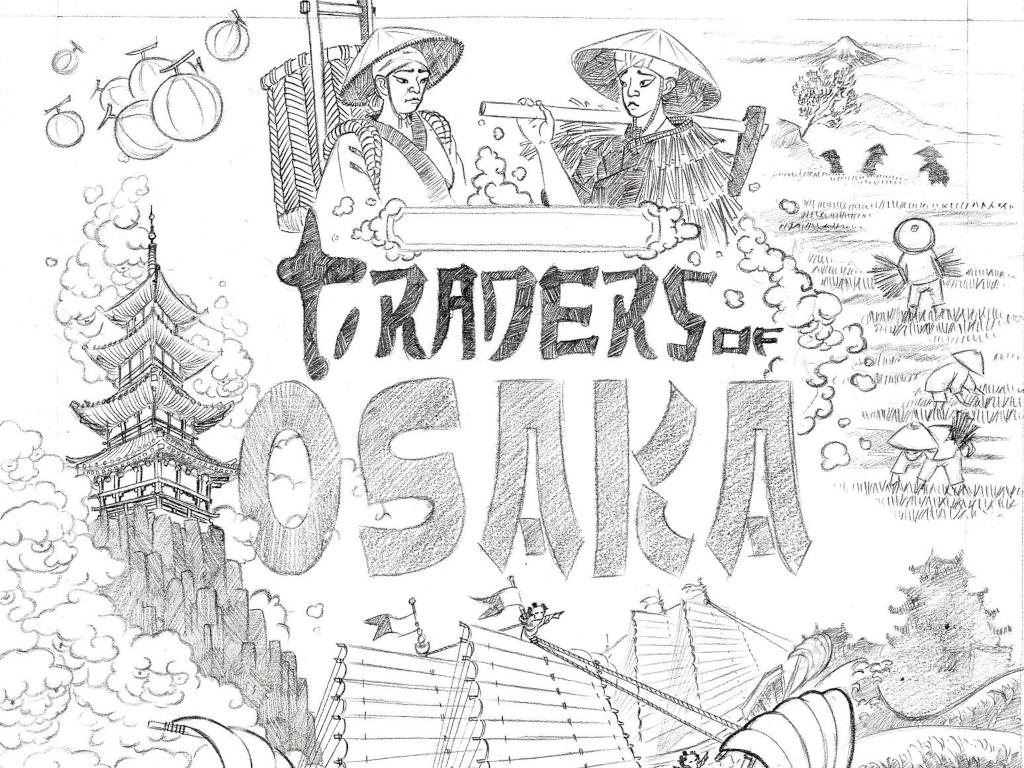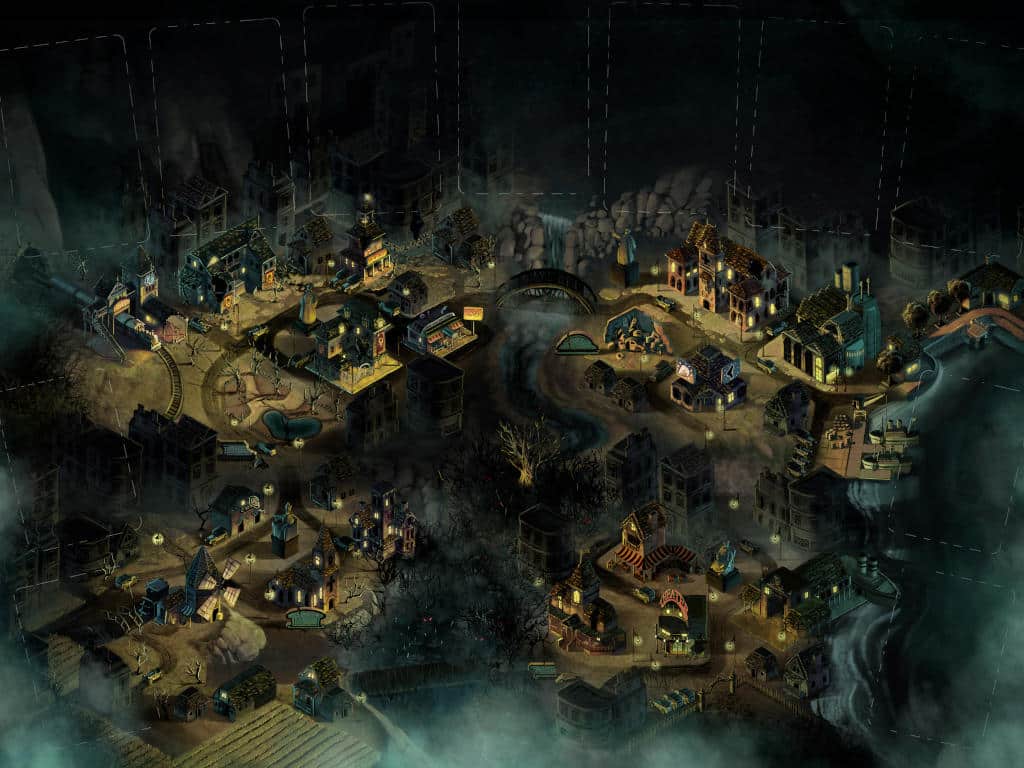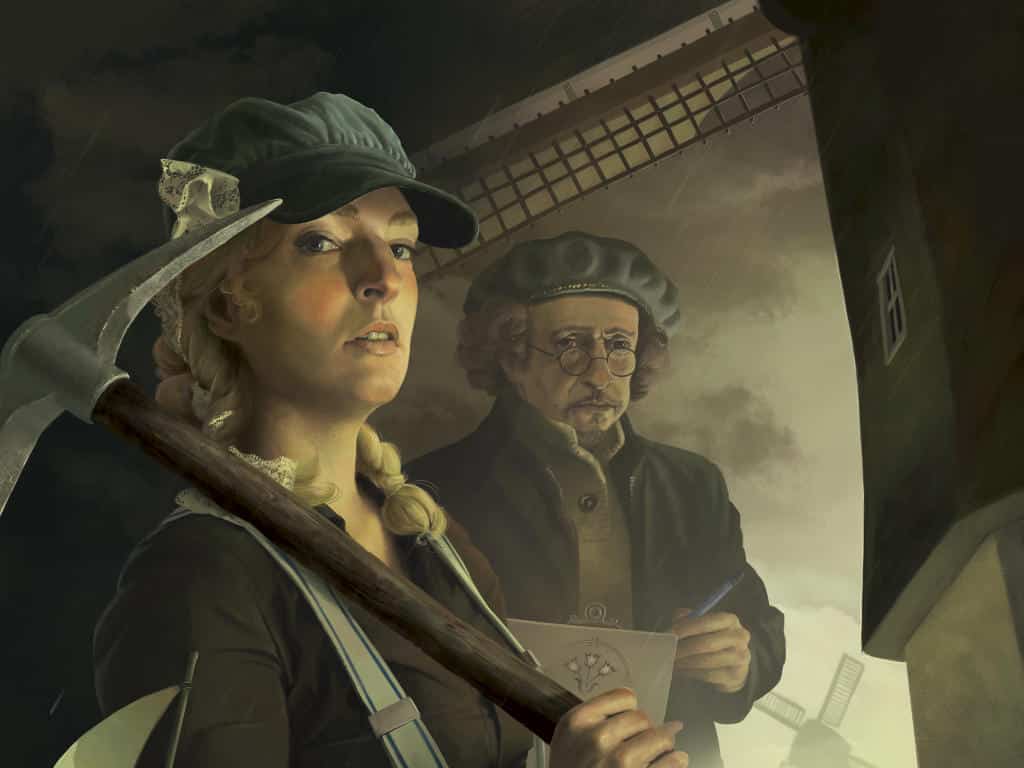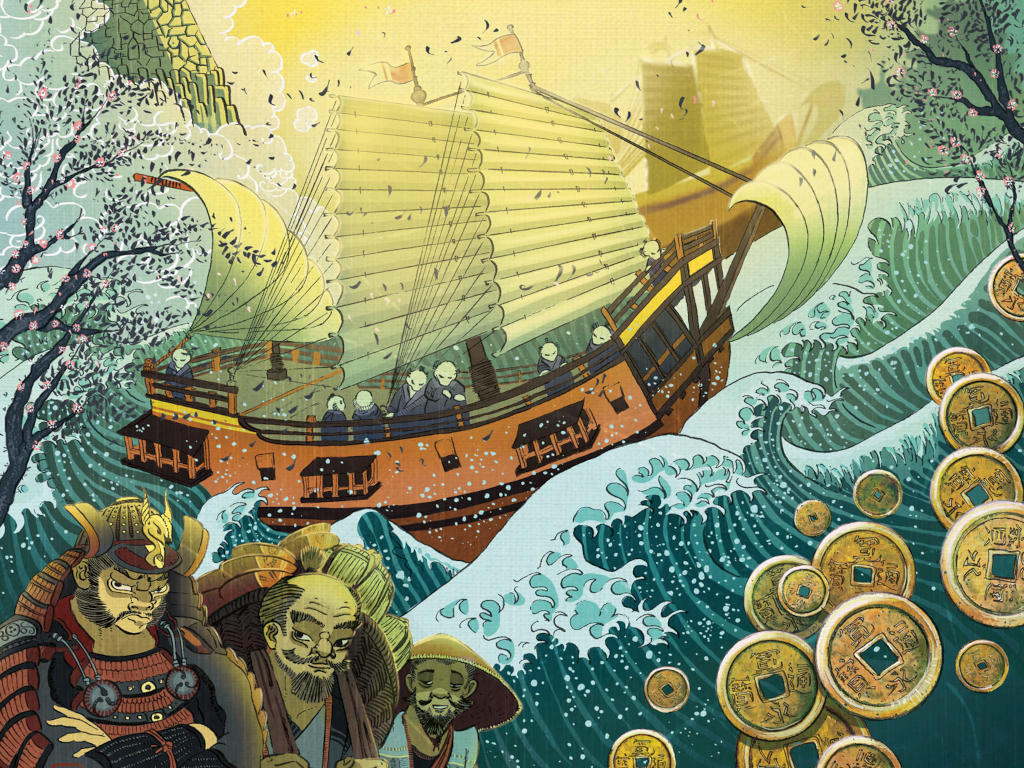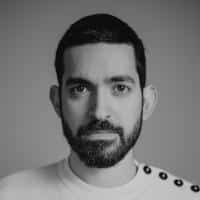
After graduating as an illustrator from Emile Cohl school in France, Atha Kanaani moved to Montréal to work for F2Z Entertainment on the game Traders of Osaka. A couple of years later he moved back to France and became a full-time illustrator for Z-Man Games. Atha has worked on games like Pandemic, Smile, Mesozooic and Through the Desert.
- Website: https://kanaani-atha.
com/ - ArtStation: https://www.
artstation. com/ atha
Audio Transcript
“Hello, my name is Atha Kanaani. Thank you very much, Oliver, for having me on your blog.
“So let’s begin. I’m a board game artist since 2014. This year I tried to contact as many board game publishers as possible. At that time, I couldn’t speak English, so I focused my research on French companies and by chance, a company from Quebec in Canada slipped into the list without me realizing it. That’s why Philosophia contacted me this
year to work with them.
“I became a boarding artist thanks to one of my teachers from art school. That’s Vincent Dutrait a great board illustrator. He had strongly advised us to go into this branch, which was very much in demand for illustrators. I didn’t really know this field. By entering it, I discovered a new exciting universe.
“The art style I’m best known for is rather realistic. I work mainly on the Pandemic series for Z-Man Games. I work on other styles, like on Smile for example or Aquarium, but most of the games I work on for the realistic style of Pandemic.
“The first board game I worked on as an artist was Traders of Osaka for which I was hired by Philosophia. It was my first real big professional project, rather stressful, because I had no idea about how to create a board game. I was terrified that I wouldn’t live up to their expectations. Luckily for me, I found an exceptional team who guided me through the process. I was very proud to see my name printed on a published project for the first time.
“The work I’m most proud of was for the game Smile. It is a very simple little card game, but one which I had great freedom. I took great pleasure in illustrating the little characters. It’s much more cartoon and colourful than the projects I usually work on. It was very relaxing to work on such a game. It gives the opportunity to free your mind and give more room for creativity. In the same spirit, I worked on the game Aquarium where we also had great freedom of interpretations. I like to work in a realistic style, but the challenge is more technical than creative and it’s nice to be able, from time to time, to get the mind wandering around in worlds that are a little more fun.
“I like to create work that allows me to explore new horizons and transmit the feeling of the game. The Pandemic series explores a new universe every time. I like to play with new patterns and finding a new emotion for each project. I wish to learn something through the illustrations I am commissioned and this can be through the subject matters that allows me to get some historical knowledge and filling my personal picture library or the style I don’t necessarily know and that invites me to acquire new technical skills. Something very complicated for me is to transmit the general emotion that comes out of the game. It’s a complex, but exciting task and you never finished learning a better way of doing things or simply a different way to quickly reach the same goal.
“Although the technical aspect of the illustration fascinates me, the final goal is not to have an illustration perfectly executed technically, but to reach the emotions of the player by allowing them to immerse themselves in their game experience. So to be precise, I like to create illustrations that won’t just be pretty but will fully participate in the positive experience of the player.
“I get my inspiration from the world around me, in the little things of everyday life. Of course, there are many artists that I admire and who surely influence my work unconsciously. I don’t take enough time to sketch everything I observe, but I love to take the time to observe people passing by, the small daily events. Learning to draw has been a fantastic experience for me. It allowed me to look at the world with more attention, to see beauty in the smallest blade of grass that replaces the concrete or tomorrow at the colourful atmosphere that changes throughout the day. Taking this time of careful observation is like a meditation for me and it nourishes me, my creativity.
“I think that the most important part in creating board game is to know how to remain humble. What I mean is that when you make a unique illustration for yourself or for a commission, the goal is to amaze the viewer in order to keep his attention on it. In a board game, we must always keep in mind that our work is there to support the game itself, to highlight it and not to put ourselves forward, in order to not taking the player out of his experience. We always want to make a piece that will make the players spend time looking at our work, but except for the cover, of course, if the game experience is constantly interrupted by too much detail here, contrast too pronounced there, we miss the real role of the illustrator which is for me to put the spotlight on the game and not on himself.
“I think the most complex part of creating board game artwork is when you are looking for the direction to take at the very beginning, when the page is still blank and the possibilities are immense. There is something stressful and exciting about starting a new project. You need to take the time to understand what it is all about, to learn as much as you can about it in the given time, but also to communicate well with the artistic team to know what is expected, so that you don’t go off-topic, but at the same time you have to let your mind go far enough to find more innovative ideas, to look for interesting solutions that will still respect the editorial line. For me, it’s a bit of a balancing act to respond correctly to more or less strict requests while having as much fun as possible. Once all the sketches are validated, the process is rather linear. There are, of course, modifications throughout the project, but it’s really the beginning that is the most interesting, but also the most complex form.
“The longest I worked on art for a board game was for the board of Pandemic: Reign of Cthulhu. It was the first time that I illustrated such a large board with so much detail. We worked a lot to find the right way to place the elements, so that the player will have the best possible experience. On the board, you don’t think about the illustration in a classical way. You don’t look for composition in the same way. You have to find some tricks to highlight the places where the player can go. Such as the rest, keep the same level of detail on the whole.
“Moreover, at that time, I didn’t have a very powerful computer and an illustration of this dimension was very complicated to make on my small laptop. I think it took me around two months to get through this illustration between all the variants and modifications. Luckily, the Z-Man Games / Philosophia art team were there throughout the process to help me in my task with great kindness.
“In my view, more board game artwork should… well I don’t really know. It’s very complicated to say what board game illustration should be in general. I feel that there are more and more artists getting involved in this industry and that’s a good thing. What I would like to see is very different style, and there are, but in general, I would like to see more creative freedom. In all areas, we are trying to recreate the style and composition that worked in the past and this is quite normal from a marketing point of view, but I think that we may be depriving ourselves of a more refreshing look, if you see what I mean. I like to be surprised, like in the movies. Most of the time we know the artistic style and we know how the script will unfold, from the beginning to the end. In board games, there are a lot of great concepts in the game mechanics, but I hope that we are not going to make the art too uniform, so that in the end we’ll only see variations of the same style on the shelves, but I know it’s complicated because you always have to find the balance between the risk of doing something new with the danger of the audience not being there. At the end, you know that if the money is not there at the end of the road, there is no more creation possible. So we must always try to find balance.
“The artist whose style I admire the most is… well choosing one is very difficult. I love Norman Walker for the energy and emotion in his painting. I find the expressiveness of his characters extraordinary and I’m fascinated by the storytelling in each of his work. To say that he’s the one I admire the most is a bit of an exaggeration, because many artists, past and present, are the object of my admiration. I’m amazed when in front of me is a work that conveys intense emotions. This ability to see the world intensely and to be able to bring the spectator into this fantastic vision is an ability that I would very much like to achieve one day.
“I would say that my favourite colour is purple, but I use it very little in my work. I admit that I find it very complicated to use. Maybe it’s only in my head, but I think it easily occupies all the space and it becomes complicated to find a nice balance with this colour. I say it’s my favourite colour and yet I will never wear any clothes or have any decoration of that colour. If I look around me right now, there is nothing purple, but yeah, I don’t know why, it’s a colour I feel good with. That’s weird.
“What very few people know about me, I would say the fact that I’m an insatiable student. I find it very hard to focus on only one subject because there are always connections being made on all sides. I like to learn all kinds of things. I like to listen to or read people who are passionate about their job or any kind of activity. Those subjects that make their eyes shine when they talk about it. I love to let my mind go on an adventure and follow the links without knowing where I’m going, to learn, I think. That’s what attracts me to art. When you’re faced with a blank page, you close your eyes, you think of a word, a sentence and if you let yourself go enough, your brain transports you into fantastic universes, but you have to know how to learn, to put the ideas on paper. It’s something I have to fight against every day to succeed in deepening the subject, because I’m a little bit like a child in a candy store, who would like to taste everything he sees without taking the time to appreciate the ones he’s eating. It’s both fantastic and tiring but I imagine that if you are able to really tame this daily wonder, the world seems wonderful to us at every moment of life, but I take great pleasure in learning a little more about myself every day and I don’t despair of being able to master this brain that runs in all directions and which I admit tires me a little bit sometimes.
“If you wanted to become a board game artist yourself, I would tell you to take a chance to contact as many people as possible in that field. I don’t really have any secret technique for entering this industry, because I got into it by chance. I would say that you need at least a representative part for you, of what you’re able to do and especially what you want to do. Make yourself visible on artist community platforms, such as ArtStation and if you are in art school, don’t do like me, don’t wait until you finish your studies to look for opportunities and above all keep on creating what you love without getting carried away by fashions or influences that are too strong. I know it’s complicated, but it’s necessary, so that you don’t lose the pleasure of drawing.
“Finally, if you want to get in touch, you can reach me on ArtStation.
“Well, there you go. I’ve reached the end. I hope that those who listen to this will have managed to understand a little, despite my horrible French accent. It was a very good experience for me and I thank you, Oliver, for giving me the opportunity to participate in your podcast.
“I wish you all the best in your life.”
Transcript by Make My Game Travel (https://makemygametravel.


